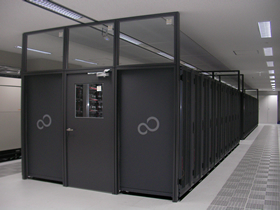SYSTEMS
JAXA Supercomputer from Fujitsu Begins Operations
Achieves world's highest computing efficiency of 91.19% -
Fujitsu Limited announced that it has completed a new supercomputer system for the Japan Aerospace Exploration Agency (JAXA). The new system began operations on April 1, 2009.Measuring the performance of the new system by running the LINPACK benchmarking tool shows performance of 110.6 teraflops and computing efficiency of 91.19%. These results would place the supercomputer at the top of the November 2008 world's TOP500 list of supercomputers in terms of computing efficiency. In terms of performance, it would rank first in Japan and 17th in the world.
Features of the new supercomputer system
The FX1 high-end technical computing server constitutes the core of the new system. This is a large-scale system, with 3,392 nodes, reaching a total theoretical peak performance of 135 teraflops and featuring 100 terabytes of memory and 11 petabytes of storage installed.
This is augmented by a number of subsystems, including vector calculation units and scalar symmetric multiprocessing units for numerical simulations that use vast amounts of memory. These allow the system to be used for a variety of purposes while offering an efficient, highly optimized computing environment.
Benchmark testing
LINPACK benchmark performance measurements on the 3,008-node FX1 primary system are as follows:
| Key Factors | Results | Compared to November 2008 TOP500 list (latest) |
|---|---|---|
| Performance | 110.6 teraflops | 1st in Japan, 17th in world |
| Efficiency | 91.19% | 1st in world |
| Runtime | 60 hours, 40 minutes | 1st in world |
How this performance was achieved
The benchmark test results can be attributed to a combination of factors: the high performance of the hardware in the FX1 technical computing server, the Parallelnavi middleware for high-performance computing (HPC) that can extract the maximum performance from that hardware, and the technical abilities involved in building the system.
The test was designed to challenge the system's maximum processing power up to the limit permitted by available memory. No runtime limit was imposed. The 3,008-node (3,008 CPUs, 12,032 cores) large cluster managed to complete the benchmark for over 60 hours under a severely high workload of more than 90%. Such results confirmed the system's high reliability.
Comment from Kozo Fujii, Director, Engineering Digital Innovation Center, JAXA
"We are excited to be using a new supercomputer with the world's best computing efficiency. In addition to pursuing aviation research, as we have done in the past, we look forward to using the new supercomputer system in the fields of rocket engine analysis and rocket plume acoustic analysis as well as for spacecraft concept design. Our goal is to make significant contributions in the practical application and development of numerical simulation technologies for space development, science, and exploration."



 How to resolve AdBlock issue?
How to resolve AdBlock issue?